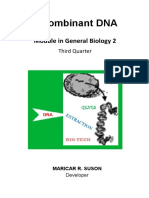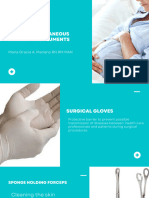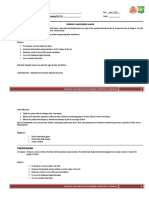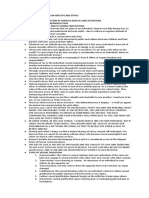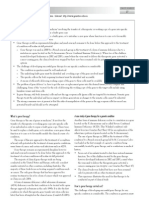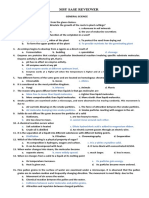Please See Chapter 8: The Nursing Role in Genetic Assessment and Counseling Page 155.
Please See Chapter 8: The Nursing Role in Genetic Assessment and Counseling Page 155.
Uploaded by
Stephanie RodriguezCopyright:
Available Formats
Please See Chapter 8: The Nursing Role in Genetic Assessment and Counseling Page 155.
Please See Chapter 8: The Nursing Role in Genetic Assessment and Counseling Page 155.
Uploaded by
Stephanie RodriguezOriginal Title
Copyright
Available Formats
Share this document
Did you find this document useful?
Is this content inappropriate?
Copyright:
Available Formats
Please See Chapter 8: The Nursing Role in Genetic Assessment and Counseling Page 155.
Please See Chapter 8: The Nursing Role in Genetic Assessment and Counseling Page 155.
Uploaded by
Stephanie RodriguezCopyright:
Available Formats
SAS 2 ’
NUR 145 Care of Mother and Child At-Risk or with Problems (Acute and Chronic)-Lecture
BS NURSING / SECOND YEAR
Session # 2
LESSON TITLE: GENETICS AND GENETICAL Materials: Notebook, pens, paper. COUNSELLING
LEARNING OUTCOMES:
At the end of the lesson, the nursing student can: References
Pilliteri, Adele (2010) Maternal and Child Health
1. Differentiate between gene replacement therapy and Nursing, 7th Edition. USA: Lippincott Williams and gene
editing. Wilkins
2. Acquire knowledge on different types of disease
inheritance. Perry, Shannon, Hockenberry, Marilyn J.,
3. Identify the different gene disorders that can be Lowdermilk Deitra Leonard and Wilson, David passed to the
patient’s offspring. (2015) Maternal and Child Nursing Care,6th
Edition. USA: Elsevier
Hockenberry, Marilyn and Wilson, David (2013)
Wong’s Essential of Pediatric Nursing,9th Edition.
USA: Elsevier
LESSON PREVIEW/REVIEW (5 minutes)
To the students: ask the students to differentiate SDG to MDG and what are the goals that pertains to Maternal and Child
Health and different statistical methods that could be use in MCN.
MAIN LESSON (50 minutes)
The instructor should discuss the following topics. Instruct the students to take down notes and read their book about this
lesson. (Please see Chapter 8: The Nursing Role in Genetic Assessment and Counseling page 155.)
Gene Replacement Therapy and Gene Editing
Gene Replacement Therapy- is an experimental technique that uses genes to treat or prevent disease.
Gene Editing- DNA is inserted, deleted, modified or replaced in the genome of a living organism targets the insertions to
site specific locations.
Genetic Disorders
- Inherited or genetic disorders are disorders that can be passed from one generation to the next because they
result from some disorder in the gene or chromosome structure.
- may occur at the moment an ovum and a sperm fuse or even earlier, in the meiotic division phase of the gametes
- 50% of 1st trimester spontaneous miscarriages Genetics -is the study of the way such disorders occur.
Cytogenetics- is the study of chromosomes by light microscopy and the method by which chromosomal aberrations are
identified.
Nature of Inheritance
Genes- are the basic units of heredity that determine both physical and cognitive characteristics of people.
Are composed of segments of DNA, which are woven into strands in the nucleus of all body cells to form chromosome.
This document and the information thereon is the property of PHINMA
Education (Department of Nursing) 1 of 2
Alleles-are the two like genes on autosomes.
Phenotype-refers to a person’s outward appearance or the expression of genes.
Genotype-refers to a person’s actual gene composition.
Genome-is the complete set of genes present (about 50,000 to 100,000).
-the collection of genetic information.
Gene-basic unit of genetic information. Genes determine the inherited characters.
Chromosomes-storage units of genes.
DNA-is a nucleic acid that contains the genetic instructions specifying the biological development of all cellular forms of
life.
Mendelian Inheritance
Gregor Mendel-described the principle of generic inheritance.
When dominant gene is paired with nondominant (recessive) ones, the dominant genes are always expressed in
preference to the recessive genes.
Ex: a gene for brown eyes is dominant over one for blue eyes.
2 healthy genes-HOMOZYGOUS
2 unhealthy genes-HETEROZYGOUS
Medical Genetics Dominant vs. Recessive
When studying rare disorders, general patterns of inheritance
are observed: Dominant- allele is expressed even if it is paired
1. Autosomal recessive with a recessive allele.
2. Autosomal dominant Recessive- allele is only visible when paired with
3. X-linked recessive another recessive allele.
4. X-linked dominant
How Does it Work?
This document and the information thereon is the property of PHINMA
Education (Department of Nursing) 2 of 2
Inheritance of Disease
1. Autosomal Dominant- either a person has 2
unhealthy genes (HOMOZYGOUS DOMINANT)
-Affected males and females appear in each
generation of the pedigree.
-Affected mothers and fathers transmit the phenotype
to both sons and daughters.
e.g.DD or is heterozygous, with the gene causing the disease
stronger than the corresponding healthy recessive gene for the
same trait e.g. Dd
Autosomal Dominant Disorders
1. Huntington’s Disease- a fatal genetic disorder that causes the progressive breakdown of nerve cells in
the brain. It deteriorates a person's physical and mental abilities usually during their prime working years
and has no cure.
2. Marfan Syndrome (Connective Tissue Disorder)- an inherited disorder that affects connective tissue —
the fibers that support and anchor your organs and other structures in your body.
3. Breast and Ovarian Cancer
4. Osteogenesis Imperfecta- also known as brittle bone disease, is a group of genetic disorders that mainly
affect the bones. It results in bones that break easily. The severity may be mild to severe.
2. Autosomal Recessive-the disease appears in male
and female children of unaffected parents. -the
disease does not occur unless 2 genes for the
disease are present (homozygous recessive pattern)
This document and the information thereon is the property of PHINMA
Education (Department of Nursing) 3 of 2
Autosomal Recessive Disorders
1. Cystic Fibrosis- an inherited disorder that causes severe damage to the lungs, digestive system and other
organs in the body
2. Albinism- a congenital disorder characterized in humans by the complete or partial absence of pigment in the
skin, hair and eyes.
3. Adrenogenital Syndrome/Congenital Hyperplasia- a group of inherited disorders that are characterized by
enlargement of the adrenal glands resulting primarily from excessive secretion of androgenic hormones by the
adrenal cortex.
4. Tay-Sach’s Disease- a rare inherited disorder that progressively destroys nerve cells (neurons) in the brain
and spinal cord.
5. Galactosemia- refers to a group of inherited disorders that impair the body's ability to process and produce
energy from a sugar called galactose. When people with galactosemia ingest foods or liquids containing
galactose, undigested sugars build up in the blood.
6. Phenylketonuria- an inborn error of metabolism that results in decreased metabolism of the amino acid
phenylalanine that can lead to intellectual disability, seizures, behavioral problems, and mental disorders. It
may also result in a musty smell and lighter skin.
7. Rh Incompatibility- condition that occurs during pregnancy if a woman has Rh-negative blood and her baby
has Rh-positive blood.
3. X-Linked Dominant- genes are located on and transmitted only by the female sex chromosome (X
chromosome) - if the affected gene is dominant, only 1 X chromosome with the trait need be present for
symptoms of the disorder to be manifested.
X-Linked Dominant Disorder
1. Alport’s Syndrome- progressive kidney failure disorder.
4. X-Linked Recessive - Usually, only males will have the disorder
-history of girls dying at birth for unknown reasons (females with affected gene on both X chromosomes)
X-Linked Recessive Disorders
1. Hemophilia A- a genetic deficiency in clotting factor VIII, which causes increased bleeding.
2. Christmas disease/Hemophilia B/Factor IX hemophilia- a rare genetic disorder in which your blood
doesn't clot properly.
3. Color blindness- often happens when someone cannot distinguish between certain colors.
4. Duchenne muscular dystrophy- a progressive form of muscular dystrophy that occurs primarily in males
5. Fragile X syndrome (cognitive challenge syndrome)- a genetic condition that causes a range of
developmental problems including learning disabilities and cognitive impairment.
Multifactorial (Polygenic) Inheritance- from multiple gene combinations + environmental factors. e.g.
Heart Disease, Diabetes Mellitus, Cleft Palate, Neural Tube Defects, Pyloric Stenosis
Chromosomal Abnormalities (Cytogenic Disorders)- abnormalities at fault in the number/structure of chromosome
which results in missing or distorted genes.
-when chromosomes are photographed and displayed, the resulting arrangement is termed a KARYOTYPE
-fluorescent in situ hybridization (FISH)-the number of chromosomes and specific parts of chromosomes can be id by
karyotyping or by this process.
Nondisjunction Abnormalities- resulting to 1 sperm/ovum having 24 & the other 22
-if this fuses with a normal sperm/ovum, the zygote will have 47 or 45 chromosomes
This document and the information thereon is the property of PHINMA
Education (Department of Nursing) 4 of 2
-the malsegregation of chromosomes due to the failure of chromosomes on the metaphase plate to divide to each
daughter nuclei
e.g. Down’s syndrome (Trisomy 21) increases with maternal & paternal age Turner
& Klinefelter syndrome
Deletion Abnormalities- chromosome disorder in which part of the chromosome breaks during cell division, causing the
affected person to have the normal # of chromosomes +/- an extra portion of a chromosome. e.g. 45.75 or 47.5
Cri-Du-Chat Syndrome (46XY5Q)/Cat Cry Syndrome- 1 portion of chromosome 5 is missing.
Translocation Abnormalities- a child gains an additional chromosome through another route. e.g.
Trisomy 21(Down Syndrome)
Mosaicism- when the nondisjunction disorder occurs after fertilization of the ovum, as the structure begins mitotic
cell division.
-different cells in the body will have different chromosome counts.
Isochromosomes- chromosomes accidentally divides not by a vertical separation but by a horizontal one, a new
chromosome with mismatched long and short arms can result.
This document and the information thereon is the property of PHINMA
Education (Department of Nursing) 5 of 2
-much the same effect as a translocation. e.g.
Turner’s Syndrome
CHECK FOR UNDERSTANDING (30 minutes)
The instructor will prepare 10-15 questions that can enhance critical thinking skills. Students will work by themselves to
answer these questions and write the rationale for each question.
Multiple Choice
(For 1-10 items, please refer to the questions in the Rationalization Activity)
RATIONALIZATION ACTIVITY (DURING THE FACE TO FACE INTERACTION WITH THE STUDENTS)
The instructor will now rationalize the answers to the students and will encourage them to ask questions and to discuss
among their classmates.
1. Amy Alvarez, 26 years of age, is pregnant with her first child and is experiencing significant stress
following her recent diagnostic findings. The nurse would be providing high-quality care if completing
which of the following?
a. Provided Amy with hope and downplaying the potential for negative outcomes
b. Referred Amy to websites and journals in the field of genetics
c. Described the most serious consequences of genetic disorders
d. Described genetics in a way that directly meets her learning needs
2. If it is predicted during a pregnancy that a couple will have a child with Down syndrome, the couple is
asked to make a choice whether they want to continue the pregnancy or terminate it at that point. To
discover how couples feel about having a child with Down syndrome, researchers surveyed 2,044 parents
on the mailing lists of six nonprofit Down syndrome organizations. The majority of parents reported they
are happy with their decision to have their child and find their sons and daughters great sources of love
and pride. Ninety-nine percent reported they love their affected son or daughter, 97% reported being
proud of them, 79% felt their outlook on life was more positive because of them, only 5% felt embarrassed
by them, and only 4% regretted having them. In a following study, siblings also reported their relationship
with their affected sibling as a positive one. Less than 10% felt embarrassed, and less than 5% expressed
a desire to trade their sibling in for another brother or sister (Skotko, Levine, & Goldstein, 2011a, 2011b).
Based on the findings of the previous studies, how would the nurse answer Mrs. Alvarez’s question, “Can
you imagine how this will change my life?”
a. “You’re right. Having a genetically affected child can potentially be a serious burden.”
b. “Don’t worry so much about what others think; just concentrate on your own life.”
c. “Change can create good things in life; I believe as a door closes, a window opens.”
d. “Would it help if you talk to a family who has a child with Down syndrome?”
3. Amy Alvarez’s child is born with Down syndrome. What is a common physical feature of newborns with
this disorder that the nurse would want all of the team members to recognize?
This document and the information thereon is the property of PHINMA
Education (Department of Nursing) 6 of 2
a. Spastic neck muscles
b. An unusual pattern of palm creases
c. A white lock of forehead hair
d. Wrinkles on the soles of the feet
4. A woman is aware that she is the carrier of a sex-linked recessive disease (Hemophilia A): her husband is
free of the disease. What frequency of this disease could she expect to see in her children? a. All the male
children will inherit it.
b. All the female children will be carrier like she is.
c. There is a 50% chance her male children will inherit the disease.
d. There is a 50% chance her female children will inherit the disease.
.
5. The nurse is caring for a child with Down syndrome (trisomy 21). This is an example of which type of
inheritance?
a. Mendelian recessive
b. Mendelian dominant
c. Chromosome nondisjunction
d. Phase 2 atrophy
.
6. The nurse prepares a couple to have Karyotype performed. What describes a karyotype?
a. A blood test that will reveal an individual’s homozygous tendencies
b. A visual representation of the chromosome pattern of an individual
c. The gene carried on the X or Y chromosome
d. The dominant gene that will exert influence over a correspondingly located recessive gene
7. A nurse is interviewing a couple who has come for a preconception visit. The couple asks the nurse
about inheritance and how it occurs. When describing the concept of genes and inheritance, the nurse
explains that a gene that is expressed when paired with another gene for the same trait is called:
a. Dominant
b. Recessive
c. Homozygous
d. Heterozygous
8. Down syndrome may occur because of a translocation defect. This means the:
a. Infants inherits chromosomal material from only one parent.
b. Parents have a chromosomal pattern that is exactly alike.
c. Additional chromosome was inherited because it was attached to a normal chromosome.
d. Parents are such close relative that their genes are incompatible.
.
9. Both people in a married couple carry the recessive gene for cystic fibrosis. When asked about
the incidence of any children developing the disorder, what should the nurse respond? a. “There is
no chance.”
b. “There is a 1 in 4 chance.”
c. “There is a 2 in 4 chance.”
d. “There is a 3 in 4 chance.”
10. When assessing a newborn identified genetically as 46XY21+, What can the nurse expect to note
on the assessment findings? Select all that apply. a. Poor muscle tone
b. Wide, lower jaw
c. Palmar crease
d. High hair line
e. Protruding tongue
LESSON WRAP-UP (5 minutes)
This document and the information thereon is the property of PHINMA
Education (Department of Nursing) 7 of 2
Teacher directs the student to mark (encircle) their place in the work tracker which is simply a visual to help students
track how much work they have accomplished and how much work there is left to do. This tracker will be part of the
student activity sheet.
You are done with the session! Let’s track your progress.
PERIOD 1
1 2 3 4 5 6 7 8 9 10 11 12 13 14 15 16 17 18 19 20
PERIOD 2
21 22 23 24 25 26 27 28 29 30 31 32 33 34 35 36 37 38 39 40
PERIOD 3
41 42 43 44 45 46 47 48 49 50 51 52 53 54 55 56 57 58 59 60
AL STRATEGY: CAT 3-2-1
This closure activity is to evaluate what the students learned after the discussion and the activity.
3-2-1 Three
things you learned:
1. __________________________________________________ 2.
__________________________________________________
3. __________________________________________________
Two things that you’d like to learn more about:
1. __________________________________________________
2. __________________________________________________
One question you still have:
1. __________________________________________________
This document and the information thereon is the property of PHINMA
Education (Department of Nursing) 8 of 2
You might also like
- CH 28 Growth and DevelopmentDocument6 pagesCH 28 Growth and DevelopmentVanessaMUellerNo ratings yet
- Answer Key Pedia (Mam G)Document22 pagesAnswer Key Pedia (Mam G)Beverly DatuNo ratings yet
- Chapter 43: Nursing Care of A Family When A Child Has An Infectious Disorder The Infectious Process #1 Infectious Disease in ChildrenDocument20 pagesChapter 43: Nursing Care of A Family When A Child Has An Infectious Disorder The Infectious Process #1 Infectious Disease in ChildrenMark oliver Gonzales100% (1)
- Chapter 014 PSDocument12 pagesChapter 014 PSJann ericka JaoNo ratings yet
- Leopold's Maneuver PDFDocument13 pagesLeopold's Maneuver PDFBiway RegalaNo ratings yet
- Mindanao State University - Iligan Institute of Technology College of NursingDocument47 pagesMindanao State University - Iligan Institute of Technology College of NursingBella OllieNo ratings yet
- Family Health NursingDocument3 pagesFamily Health Nursingmarjo24100% (1)
- Prodcut of Recombinat DNA TechnologyDocument9 pagesProdcut of Recombinat DNA TechnologySHOAIB NAVEEDNo ratings yet
- Recombinant DNA: Module in General Biology 2Document27 pagesRecombinant DNA: Module in General Biology 2Shastine Claor100% (1)
- Bimm 120 Midterm 1Document28 pagesBimm 120 Midterm 1Melissa LauNo ratings yet
- Parental Concerns Associated With The Toddler PeriodDocument3 pagesParental Concerns Associated With The Toddler PeriodMarc Glico ComonNo ratings yet
- Chapter 10: Nursing Care Related To Psychological and Physiologic Changes of PregnancyDocument4 pagesChapter 10: Nursing Care Related To Psychological and Physiologic Changes of PregnancyAlyssaGrandeMontimor0% (1)
- Epidemiology and The Nurse: CHN 2 113 LECDocument20 pagesEpidemiology and The Nurse: CHN 2 113 LECLRBNo ratings yet
- High Risk Newborn (8 Priorities)Document48 pagesHigh Risk Newborn (8 Priorities)Raquel MonsalveNo ratings yet
- Family Nursing ProcessDocument69 pagesFamily Nursing ProcessBea Bianca CruzNo ratings yet
- Nursing Care of A Family With An Ill ChildDocument5 pagesNursing Care of A Family With An Ill ChildAmna JalilNo ratings yet
- Module 6 - FILIPINO CULTURE, VALUES AND PRACTICES IN RELATION TO MATERNAL AND CHILD CAREDocument4 pagesModule 6 - FILIPINO CULTURE, VALUES AND PRACTICES IN RELATION TO MATERNAL AND CHILD CAREKatie Holmes0% (1)
- Week 8 - Activity (Case Scenario)Document7 pagesWeek 8 - Activity (Case Scenario)Jollan Marie BuenvenidaNo ratings yet
- Family Health Nursing CHN (Start Midterm)Document4 pagesFamily Health Nursing CHN (Start Midterm)Aiza OronceNo ratings yet
- 11Document6 pages11Wiljohn de la CruzNo ratings yet
- Patterns of Occurrence and DistributionDocument10 pagesPatterns of Occurrence and DistributionKrischelle AlimaNo ratings yet
- Nursing Care of The Family Having Difficulty Conceiving A ChildDocument10 pagesNursing Care of The Family Having Difficulty Conceiving A ChildAndrei Borata100% (2)
- Origin and Development of Organ SystemsDocument13 pagesOrigin and Development of Organ SystemsRaquel MonsalveNo ratings yet
- Chapter 12: Nursing Care To Promote Fetal and Maternal HealthDocument9 pagesChapter 12: Nursing Care To Promote Fetal and Maternal HealthAlyssaGrandeMontimorNo ratings yet
- MMDST PAPER (Not Yet Final) Part 1Document10 pagesMMDST PAPER (Not Yet Final) Part 1ncamille18No ratings yet
- Transcultural Nursing Across The Life Span: Ma. Flossie L. TangpuzDocument23 pagesTranscultural Nursing Across The Life Span: Ma. Flossie L. TangpuzSheila VerbaNo ratings yet
- Nursing Care of The Family Experiencing A Sudden Pregnancy ComplicationDocument7 pagesNursing Care of The Family Experiencing A Sudden Pregnancy ComplicationDacillo GailleNo ratings yet
- Individual Activity 3 PDFDocument11 pagesIndividual Activity 3 PDFBanana QNo ratings yet
- 1.Mcn FamilyDocument45 pages1.Mcn FamilymanilynNo ratings yet
- Prelim Examination MaternalDocument23 pagesPrelim Examination MaternalAaron ConstantinoNo ratings yet
- Midterm ReviewerDocument37 pagesMidterm ReviewerAruxi YoshiNo ratings yet
- Npi Format For Rle 1Document9 pagesNpi Format For Rle 1Patricia VasquezNo ratings yet
- Leopold's ManeuverDocument2 pagesLeopold's ManeuverAnnaAlfonsoNo ratings yet
- Case Study On Communicable DiseaseDocument15 pagesCase Study On Communicable DiseaseThiradevi BalakrisnanNo ratings yet
- MCN Normal LaborDocument37 pagesMCN Normal LaborJharaNo ratings yet
- CHNDocument4 pagesCHNJulia Dela CruzNo ratings yet
- Foundation For Maternal and Child Health NursingDocument18 pagesFoundation For Maternal and Child Health NursingChari RivoNo ratings yet
- Framework of MCNDocument3 pagesFramework of MCNAngelica JaneNo ratings yet
- CU Week 16 NURSING CORE VALUES AS A COMMUNITY HEALTH NURSEDocument7 pagesCU Week 16 NURSING CORE VALUES AS A COMMUNITY HEALTH NURSEMizuiro Senpai100% (1)
- NCM 107 Module 2MDocument8 pagesNCM 107 Module 2MAlyssa Claire TumulakNo ratings yet
- Elderhood: Jerry Mae Chiong Joliza Lancara Dianne Kay Fernandez Rhea Joy GolenaDocument50 pagesElderhood: Jerry Mae Chiong Joliza Lancara Dianne Kay Fernandez Rhea Joy GolenaRj Santiago0% (1)
- CHN (Community Health Nursing)Document7 pagesCHN (Community Health Nursing)Sarah Jane MaganteNo ratings yet
- Famorca Et Al. 2013. Nursing Care of The CommunityDocument126 pagesFamorca Et Al. 2013. Nursing Care of The CommunityShyne HazyNo ratings yet
- Weekly Requirement OB WardDocument12 pagesWeekly Requirement OB WardXerxes DejitoNo ratings yet
- Surgical AsepsisDocument1 pageSurgical AsepsisMerielLouiseAnneVillamilNo ratings yet
- Chapter 43: Nursing Care of A Family When A Child Has An Infectious DisorderDocument12 pagesChapter 43: Nursing Care of A Family When A Child Has An Infectious DisorderAlyssaGrandeMontimorNo ratings yet
- Filipino Culture, Values and Practices in Relation To Health Care of Individual and FamilyDocument12 pagesFilipino Culture, Values and Practices in Relation To Health Care of Individual and FamilyRainy Days100% (1)
- NURSING INFORMATICS - ResearchDocument11 pagesNURSING INFORMATICS - ResearchANHIBEY, JEZREEL ACE S.No ratings yet
- NSD InstrumentsDocument16 pagesNSD InstrumentsGracias Grasyah Agcaoili MarianoNo ratings yet
- Nursing Care During LaborDocument12 pagesNursing Care During LaborJulianne B. Dela CruzNo ratings yet
- Chapter 9: Nursing Care During Normal Pregnancy and Care of The Developing FetusDocument8 pagesChapter 9: Nursing Care During Normal Pregnancy and Care of The Developing FetusAlyssaGrandeMontimor100% (1)
- Intrapartum NCM 107Document8 pagesIntrapartum NCM 107Kimberly Sharah Mae Fortuno100% (1)
- Nursing Informatics 9 16 PDFDocument52 pagesNursing Informatics 9 16 PDFFaith CalimlimNo ratings yet
- 3rd Year CHN - Nursing Process in The Care of A CommunityDocument19 pages3rd Year CHN - Nursing Process in The Care of A CommunityTzarina CatipayNo ratings yet
- P2 NCP 1Document4 pagesP2 NCP 1Kyle Albert EstoestaNo ratings yet
- Script For Leopold's Maneuver (Autorecovered)Document3 pagesScript For Leopold's Maneuver (Autorecovered)lea mae andoloyNo ratings yet
- Nursing Informatics TheoriesDocument11 pagesNursing Informatics TheoriesFilamae Jayahr Caday67% (6)
- Evaluation Examination For Medicine WardDocument3 pagesEvaluation Examination For Medicine WardMarvick GalimaNo ratings yet
- Nursing Care of A Child With Respiratory DisorderDocument69 pagesNursing Care of A Child With Respiratory DisorderTamil Villardo100% (1)
- NCM 107 NCM 109 Case Study FormatDocument7 pagesNCM 107 NCM 109 Case Study FormatCharme Jean RaygonNo ratings yet
- Midterm Coverage - NCM 108 Health Care Ethics NotesDocument10 pagesMidterm Coverage - NCM 108 Health Care Ethics NotesAudrie Allyson GabalesNo ratings yet
- Ventricular Septal Defect, A Simple Guide To The Condition, Treatment And Related ConditionsFrom EverandVentricular Septal Defect, A Simple Guide To The Condition, Treatment And Related ConditionsNo ratings yet
- MCN1 Sas 4Document10 pagesMCN1 Sas 4Vendheyl LegaspiNo ratings yet
- Sickle Cell Student-LabDocument12 pagesSickle Cell Student-LabS. Spencer100% (1)
- Scandinavian Med Sci Sports - 2022 - Angleri - Resistance Training Variable Manipulations Is Less Relevant Than IntrinsicDocument26 pagesScandinavian Med Sci Sports - 2022 - Angleri - Resistance Training Variable Manipulations Is Less Relevant Than IntrinsicDaniloNo ratings yet
- Didier Montet, R.C. Ray - Aquaculture Microbiology and Biotechnology, Vol. 1 (2009, Science Publishers) PDFDocument274 pagesDidier Montet, R.C. Ray - Aquaculture Microbiology and Biotechnology, Vol. 1 (2009, Science Publishers) PDFMst Pany100% (1)
- Biology of Okra 1Document2 pagesBiology of Okra 1YASHPAL SINGHNo ratings yet
- Prion (CJD), Lahiru Perera, 23416785Document6 pagesPrion (CJD), Lahiru Perera, 23416785Lahiru PereraNo ratings yet
- 155ORIGINALDocument14 pages155ORIGINALagos PlzNo ratings yet
- Class 12 - Biology - Molecular Basis of InheritanceDocument10 pagesClass 12 - Biology - Molecular Basis of InheritanceLUCIFERNo ratings yet
- Introduction and History of BiotechnologyDocument22 pagesIntroduction and History of BiotechnologyMuhammad Shihab GhauriNo ratings yet
- Principles of Inheritance and VariationDocument25 pagesPrinciples of Inheritance and VariationAshwani PathakNo ratings yet
- CBSE Class 10 Term 2 Heredity and Evolution Study NotesDocument21 pagesCBSE Class 10 Term 2 Heredity and Evolution Study Notesg0484031No ratings yet
- TranscriptionDocument72 pagesTranscriptionMurthy MandalikaNo ratings yet
- Yi Han - Fall Semester Exam Review 2024Document7 pagesYi Han - Fall Semester Exam Review 2024mellomellotrelloNo ratings yet
- Gene Therapy PDFDocument3 pagesGene Therapy PDFhmak2002No ratings yet
- Transcription Q&ADocument7 pagesTranscription Q&AGabriel Delos Reyes100% (1)
- (생명과학) (포스터) (경기과학고등학교) (정예찬)Document1 page(생명과학) (포스터) (경기과학고등학교) (정예찬)조수호No ratings yet
- Sase Reviewer (Science)Document9 pagesSase Reviewer (Science)Ashley Jean CosmianoNo ratings yet
- Xii CH 6 Molecular Basis of Inheritance HssliveDocument12 pagesXii CH 6 Molecular Basis of Inheritance HsslivejebintinyNo ratings yet
- Instant Download Ebook PDF Biological Science 2nd Canadian Edition PDF ScribdDocument41 pagesInstant Download Ebook PDF Biological Science 2nd Canadian Edition PDF Scribdmatthew.weimar370100% (56)
- Prokariotik and Eukariotik GenesDocument68 pagesProkariotik and Eukariotik Genesarief270490No ratings yet
- Extension of Mendelian GeneticsDocument110 pagesExtension of Mendelian GeneticsHannah OrtoyoNo ratings yet
- Chromosomes WorksheetDocument6 pagesChromosomes WorksheetPaulína PalčinskáNo ratings yet
- Genetics CancerDocument206 pagesGenetics CancerDr. Serin KuriakoseNo ratings yet
- Insulin (Red Biotechnology)Document3 pagesInsulin (Red Biotechnology)Enrique Gonzalodo IIINo ratings yet
- Nature and Nurture: Chapter 3 99-133Document18 pagesNature and Nurture: Chapter 3 99-133yummywords1254100% (1)
- Humangenomeproject 141104093604 Conversion Gate02Document23 pagesHumangenomeproject 141104093604 Conversion Gate02Nishant ChandavarkarNo ratings yet
- Vargas Et Al. 2016Document9 pagesVargas Et Al. 2016Carlos MaureiraNo ratings yet
- Longevity ReportDocument3 pagesLongevity ReportAlvatrox MarcNo ratings yet








